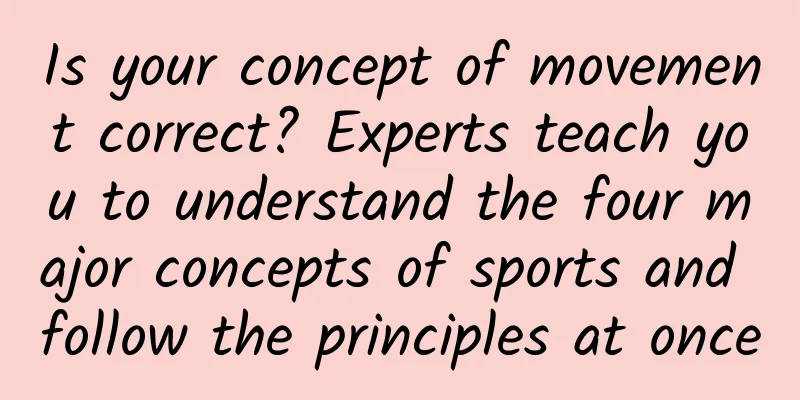Is your concept of movement correct? Experts teach you to understand the four major concepts of sports and follow the principles at once

|
I sometimes find that we are more overwhelmed than ever by the amount of academic information, news gossip, and marketing gimmicks we receive about sports training. Therefore, I feel it is necessary to clarify some of the current concepts, restate the principles of managing a sports plan, and break it down into simpler and more relevant information that is easier for everyone to use. Once you understand these concepts and principles, you will not only learn the surface fitness terms, but also see beyond them and have the management ability to increase or decrease exercise, avoid overtraining, and ensure that your health is moving in line with the goals you set. First, we must understand the difference between concepts and principles. Definition of concept "Concept" can also be defined as "central idea". When applied to sports, it can be the basis or principle of a certain sport. Since concepts are "ideas", they are easily influenced by human factors. These concepts come and go, and some are even repackaged as “new” ideas through new rhetoric (this happens all the time in the fitness world and in everyday life). Certain concepts, such as “core stability,” drive long-term trends and behavioral changes in sports and fitness, and form the basis of exercise genres such as Pilates or Barre. Some concepts appear suddenly and become popular for a while, but they disappear as quickly as they appeared. Definition of Principles "Principles" are natural laws that are universally accepted, scientifically based and proven, and applicable to a wide range of applications, such as sports and fitness. Principles are immutable laws that we can follow and use, and their importance cannot be ignored. The principles followed in the book apply to exercise physiology, fitness, and the body's response to exercise. These principles never change, no matter what new ideas, trends, or fads surround you, and whether you’re running marathons, doing CrossFit, or doing a simple home workout in your living room, these principles still apply. I have a mantra I often say: understand the concepts, use the concepts, but never abandon the principles. Key Concepts 1. Individuality Personal health is the product of a combination of four factors: family genetics, past history, lifestyle and environment. Now, you cannot control the first two factors, but the latter two are closely related to personal behavior. You can make choices and changes based on your current lifestyle and environment, which will have a positive or negative impact on your happiness. This is your power as an independent individual. Furthermore, even if our physiology is identical, our genetic code creates different variability. So what I'm saying is that not all exercise plans, fitness menus or training programs are suitable for everyone, not everyone can start training with the same intensity or volume, and not everyone progresses at the same speed. This doesn't mean that what you are doing is wrong or that you are weak. It just means that individual differences need to be taken into account when developing an exercise plan. There is no such thing as a perfect exercise plan, but I believe there must be a plan that is suitable for you and can meet your needs and goals. A healthy, safe and effective exercise program can help you get better, leaner, more flexible and stronger on your own terms. At the beginning, start with a level that you can sustain and make time for exercise. Especially when you are a beginner, remember to seek help from a professional coach. 2. Physical fitness (physical adaptability) In the 2000s, organizations such as the American College of Sports Medicine (ACSM) began to establish guidelines for exercise, health promotion, and lifestyle disease prevention. A 2012 report showed that more than half of Americans failed to meet these guidelines. In fact, as many as three-quarters of Americans are considered to lack physical activity. Around 2000, as the impact of the millennial generation began to take effect, new perspectives were added and physical fitness was redefined. This independent generation not only pursued health, but was also interested in pursuing stronger physical fitness. One of the most recent definitions of physical fitness was proposed by Greg. It was developed by Greg Glassman in the early 2000s at CrossFit, a company he founded. He defines physical fitness as increasing your activity and mastering the 10 key competencies of functional fitness. These abilities are cardiorespiratory endurance, muscular endurance, strength, flexibility, explosive power, speed, coordination, flexibility, balance and accuracy. 3. Functional Movement Functional training helps ensure an optimal quality of life to face daily demands. It is a category of exercise that involves training the body to perform everyday movements such as standing, throwing, lifting, pulling, climbing, running and punching in a manner similar to everyday exercise. Functional movements use internationally recognized motor unit recruitment patterns, contract from the core to the body surface, and are compound and multi-joint movements. The key principles for restoring and optimizing functional movement patterns are to first strengthen postural stability and maximize joint range of motion. Once a foundation is established, higher levels of functional strength can be developed in the active muscle groups. Exercise should be wide and varied, and should be continuous in both load and frequency. 4. High-intensity interval training High-intensity interval training consists of repeated bursts of movement followed by intervals. After each set of high-intensity movements, there is a preset rest period or low-intensity exercise between sets. Several cycles are usually repeated, for example, performing as many reps as possible in 20 seconds, resting for 10 seconds, and then repeating, repeating, repeating. High-intensity interval training is a shorter, yet more challenging exercise. The entire procedure usually takes 4 to 12 minutes, but rarely takes up to 20 minutes. High-intensity exercise is generally considered to reach 80% or higher of the "estimated maximum heart rate" (PMHR); with intermittent recovery periods in between, the estimated maximum heart rate is generally 40% to 50%, which is a comfortable level. This type of training is widely used in many sports. The popularity of this type of training stems from a study performed by athletes on the Japanese Olympic speed skating team on a bicycle ergometer. The process is 20 seconds of high-intensity exercise followed by 10 seconds of rest, for a total of 8 rounds, which is called the "Tabata scientific experiment." This study and others since have shown that high-intensity interval training can produce better results than longer, gentle exercise. Additionally, because many millennials say they don’t have time for long, steady-state workouts, other exercises are losing ground to high-intensity interval training, such as Orange Theory circuit training, Zumba, Soul Flyer, and CrossFit. But people sometimes overlook that true high-intensity interval training may be more likely to lead to injury and overtraining, especially for people without a fitness foundation and those who over-exercise. In fact, most people who think they are doing high-intensity interval training may actually be doing more "high-intensity variable training" (HIT), which means that the heart rate levels and rest times vary more, thus reducing the injuries and overtraining that may be caused by the original process. Training principles to follow 1. Special adaptation principle The Specific Adaptation to Imposed Demands (SAID) principle states that the body will make expected changes during the adaptation process due to specific movement demands. For example, jogging stimulates adaptive responses in the body, improves physiological functions, and makes the body more suitable for running. Basically, all kinds of positive stimulation produced during the adaptation period can bring about better physical responses. If you run regularly, you will run better; if you ride a bike regularly, you will have better riding performance. This is the "specificity principle". How quickly or slowly the body adapts is highly dependent on the individual, but beginners or those with very poor functional movement abilities are likely to make rapid progress. 2. Progressive Overload To improve athletic performance, the body must be stimulated to perform activities beyond its current capabilities. For example, if you want to increase your muscle strength, you need to do weight training with a weight higher than you can currently bear. This stimulation is called "overload." If you want to continue to improve your muscle endurance, strength, and speed, you must keep practicing. The principle of progressive overload is that exercise needs to be continuous and repeated while gradually increasing the load to break through the original adaptation level. There are four main overload variation factors in any sports training: exercise frequency, intensity, type and number (duration). If you want to increase the load, you can strengthen one of them. However, the movements in this training method do not have to be the same every time, nor does it mean that the intensity can only be increased a little bit each time. On the contrary, even the movements must be varied. While completely random and inconsistent training may slow down improvements in one ability, another ability may improve more steadily. Once you stop increasing overload, performance will stagnate. If you don’t continue exercising, the abilities you’ve acquired previously will regress. This is the “reversibility principle.” When using progressive overload, good, stable form is key, and correct form is an absolute priority. On the other hand, if you want to improve your movement speed, explosive power, or perform "enhanced training", you must have a certain muscle strength foundation. 3. Periodization Beginners will see significant improvement when they first start progressive overload training. But as abilities gradually reach their peak and the amount of overload gradually decreases, the rate of improvement will become smaller, which is a natural phenomenon of stagnation. To overcome this, intermediate and advanced athletes design more structured training schedules with fluctuating exercise cycles and periods, which we call "periodization." This type of training allows athletes to break through a plateau and continue to improve, even if the progress is smaller. 4. Exercise intensity In short, exercise intensity can be used to measure the intensity of training. When training at a moderate intensity, the average person can exercise longer; when training at a high intensity, fatigue will occur faster. As mentioned above, short-term high-intensity training can significantly improve athletic ability, but if you overtrain or use it without a certain exercise foundation, it is very likely to cause physical fatigue and injury. Exercise intensity can be increased in several main ways. To increase strength and power, lift heavier weights, faster, more times, and with shorter rest periods. If you are doing typical aerobic exercise, you can move faster while keeping your heart rate higher. Simply put, the key is to train at a certain intensity so that progressive overload training can enable us to continuously improve our abilities within the scope of our efforts. As your athletic foundation improves and your training level stabilizes, changing your exercise intensity will become an important key to periodized training. This article comes from Dialect Culture [Weight Training] Muscle Anatomy and Function Analysis Coaching Book: Exercise the entire body, effectively shape the body, avoid injuries, and enhance muscle endurance and explosive power! A book |
<<: [Video version] This exercise is essential to increase immunity during the epidemic!
Recommend
What should women do if they have cervicitis?
Cervicitis is a common disease in women's liv...
What are the causes of pelvic inflammatory disease?
Do you know the causes of pelvic inflammatory dis...
Talk about the precautions in daily life for patients with moderate cervical erosion
Moderate cervical erosion is a mid-stage disease....
What is the best way to treat cervical erosion?
Cervical erosion is very harmful to women, and th...
How to deal with irregular menstruation? A complete guide to women's care, easily regulate your period!
Irregular menstruation is a problem faced by many...
What are the hazards of chronic cervicitis in women? Dietary considerations for chronic cervicitis in women
Cervicitis is a common gynecological disease in w...
Understand which women in life need to take good care of ectopic pregnancy prevention
I think women in our lives should know something ...
How is bacterial vaginosis transmitted?
Bacterial vaginosis is a stubborn disease that is...
What are the methods to check for irregular menstruation?
What are the methods to check irregular menstruat...
The harm of low menstrual flow in women
Women with light menstruation should eat a balanc...
What are the side effects of birth control pills for women?
With the development of society, people are choos...
Women should take good contraceptive measures to prevent cervicitis
It is good for women's health to prevent cerv...
Correct understanding of cervicitis is very important
Everyone wants to have a healthy body, but there ...
When is the best time to have an abortion?
It is more appropriate to have an abortion within...
Principles to be followed in treating menopause
For every woman, the transition from adolescence ...









